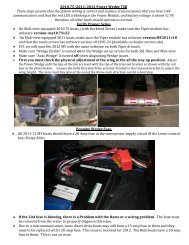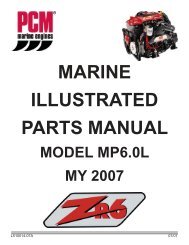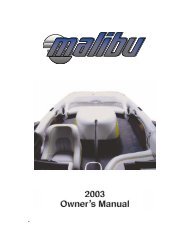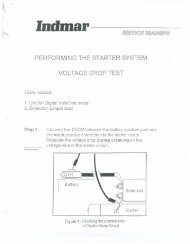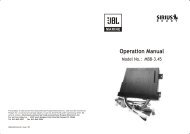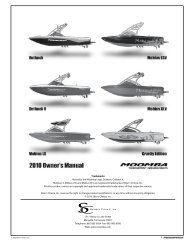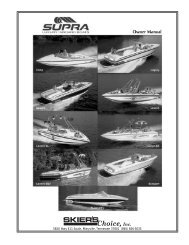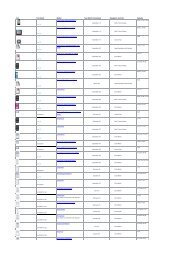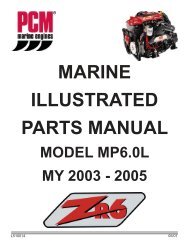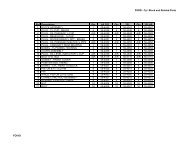LS7 Corvette Mechanical Repair Specs (PDF) - Bakes Online
LS7 Corvette Mechanical Repair Specs (PDF) - Bakes Online
LS7 Corvette Mechanical Repair Specs (PDF) - Bakes Online
- No tags were found...
Create successful ePaper yourself
Turn your PDF publications into a flip-book with our unique Google optimized e-Paper software.
Print Preview Version 8.0 PubTeX output 2006.06.15:1036 File: C:\DOCUME~1\PCOMPO~1.IGS\LOCALS~1\Temp\.aptcache\2006<strong>LS7</strong>/tfa01804.dvi User: PComposer Page: 2532006 Y Car GMX245 <strong>Corvette</strong>7.0L (<strong>LS7</strong>) Engine <strong>Mechanical</strong>Exhaust ManifoldsThe hydro-formed stainless steel exhaust headers are a 1 piece steel design with unique quad flow collector flanges. Theexhaust manifolds direct exhaust gasses from the combustion chambers to the exhaust system. Each manifold also has anexternally mounted heat shield that is retained by bolts.Intake ManifoldThe intake manifold is a friction welded 3 piece composite design that incorporates brass threaded inserts for mountingthe fuel rail, throttle body, and wire harness studs. Each side of the intake manifold is sealed to the cylinder head by4 non-reusable push-in-place silicone sealing gaskets. The 90 mm (3.54 in) electronically actuated throttle body bolts to thefront of the intake manifold. The throttle body is sealed by a 1 piece push-in-place silicone gasket. The fuel rail assembly,with 8 separate fuel injectors, is retained to the intake by 4 bolts. The injectors are seated into their individual manifold boreswith O-ring seals to provide sealing. 2 fuel rail stop brackets are retained to the rear of the intake manifold by mountingbolts. The manifold absolute pressure (MAP) sensor is installed and retained to the top front of the intake manifold andsealed by an O-ring seal. The evaporative (EVAP) emission canister purge solenoid valve is mounted to the front of theright cylinder head. There are no coolant passages within the intake manifold.Oil PanThe structural oil pan is cast aluminum. Incorporated into the design are the oil filter mounting boss, drain plug openingand internal oil passages. The alignment of the structural oil pan to the rear of the engine block and transmissionhousing is critical.Piston and Connecting Rod AssemblyThe pistons are cast aluminum. The pistons use 2 compression rings and 1 oil control ring assembly. The piston is a lowfriction, lightweight design with a recessed top and barrel shaped skirt. The piston pins are chromium steel and are afull-floating design. The connecting rods are forged titanium alloy with press-in-place piston pin bushings. The connectingrods and rod cap are aligned by dowel pins retained in the cap. All applications use a piston with a graphite coated skirt.The piston, pin, and connecting rod are to be serviced as an assembly.Valve Rocker Arm Cover AssembliesThe valve rocker arm covers are cast aluminum and use a pre-molded silicon gasket for sealing. Mounted to each rockercover is a coil and bracket assembly. Positive crankcase ventilation (PCV) fresh air passages are incorporated into both theleft and right side covers. The cap on the right valve cover is not to be used for oil fill.Valve TrainMotion is transmitted from the camshaft, through the hydraulic roller valve lifters and tubular pushrods, to the roller typerocker arms. The nylon valve lifter guides position and retain the valve lifters. The valve rocker arms for each bank ofcylinders are mounted directly to the cylinder heads. Each rocker arm is retained to the cylinder head by a bolt. Valvelash is net build. The exhaust valves have sodium filled valve stems. The intake valves are a titanium design and have arocker arm wear pad at the top of the stem.Description and Operation1674147New Product InformationThe purpose of New Product Information is to highlight, or indicate, important product changes from the previousmodel year.Changes may include 1 or more of the following items:• Torque values and/or fastener tightening strategies• Changed engine specifications• New sealants and/or adhesives• Disassembly and assembly procedure revisions• Engine mechanical diagnostic procedure revisions• New special tools required• A component comparison from the previous yearTorque Values and/or Fastener Tightening Strategies253 of 272




